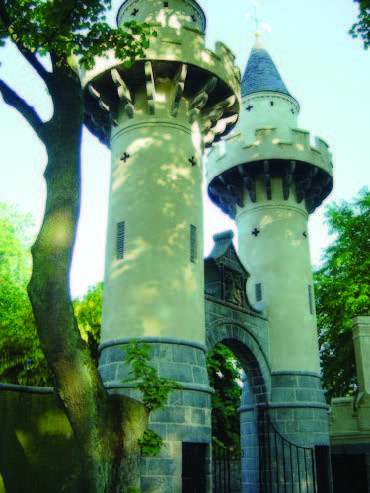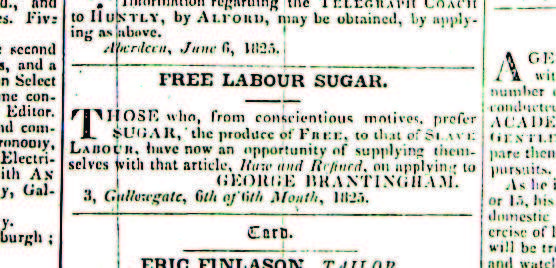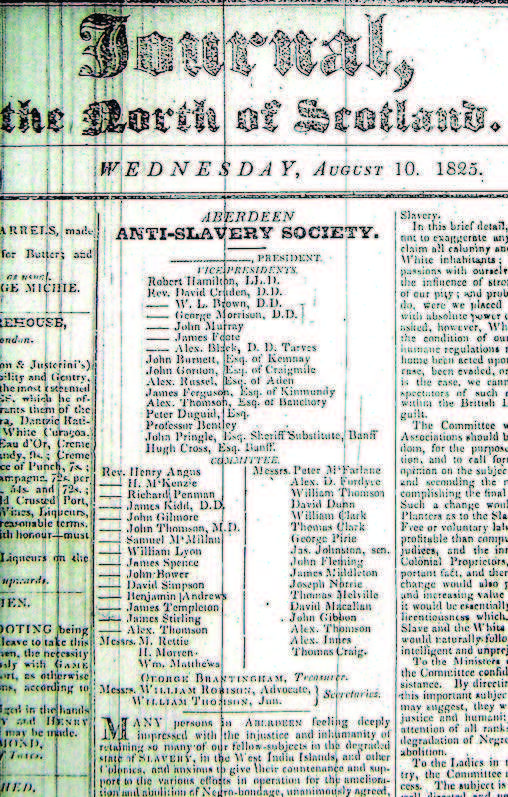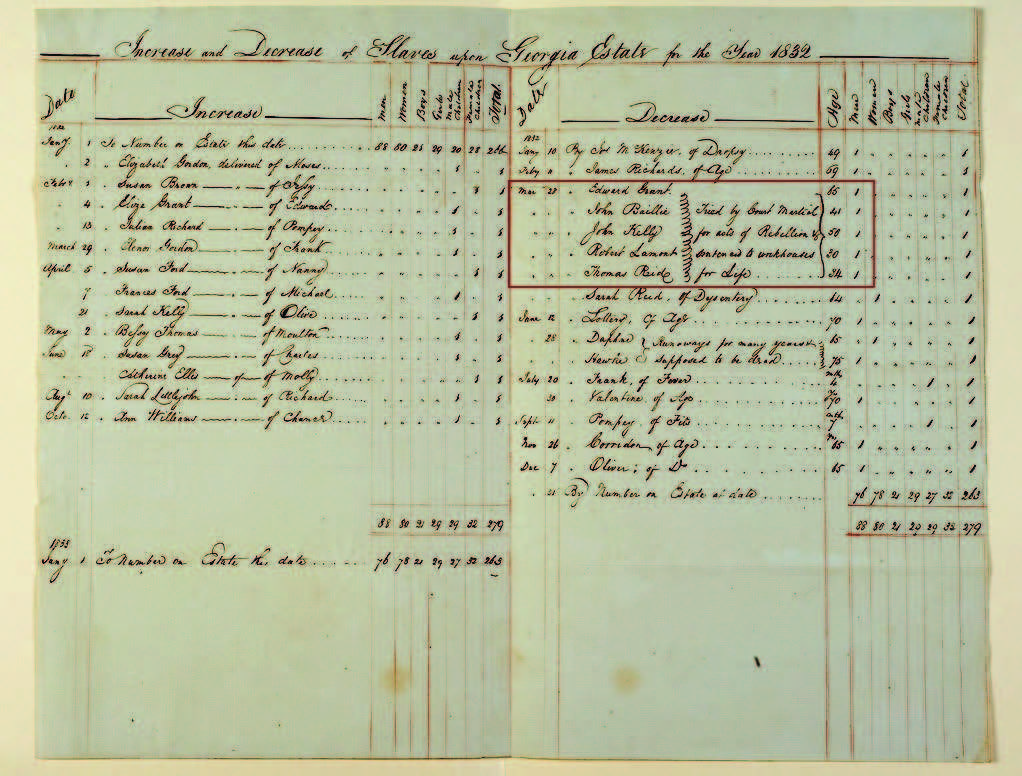Ending slavery

Between 1834 and 1838, Britain ended slavery in its colonies. Enslaved people became free workers, entitled to wages from their former owners and permitted to live and work where they chose.
The fight to end slavery, like the fight against the slave trade, was a long one. In Aberdeen it began in 1825 with the formation of a local anti-slavery society. George Brantingham, a Quaker grocer, was its energetic treasurer. A practical man, he stocked up on sugar imported from India so that his customers could buy sugar that was not grown by enslaved people.
The Aberdeen Anti-Slavery Society included leading citizens of the city and shire, especially clergymen and academics. But the North East still had strong commercial ties to the Caribbean and many slavers and merchants opposed the campaign. The Aberdeen Journal was filled with angry letters arguing for and against slavery.
In the Caribbean, the enslaved people themselves demanded their freedom, repeatedly and forcefully. Massive uprisings erupted in Barbados in 1816 and Guyana in 1823, but the biggest occurred in Jamaica, just after Christmas 1831. Government troops suppressed it brutally, executing hundreds of people. But to many people in Britain, this only proved that protecting enslavers cost too much money and blood. Soon afterwards, parliament passed the first Emancipation Act.
Although defeated, slavery left many bitter legacies. Caribbean societies were sharply divided by poverty, racism and resentment. Beyond the Caribbean too, relations between Europeans and Africans were horribly scarred by the long history of enslavement and prejudice.
"The Emancipation of our people from slavery and all it signifies in terms of human cruelty, suffering, sacrifice, folly, courage, deception, greed, triumph of the human spirit and faith and hope cannot be allowed to slip from our collective memory. There are lessons to be learnt that are of lasting value."
Revd Burchell Taylor, Pastor of Bethel Baptist Church, Jamaica
Emancipation
Parliament passed the first Emancipation Act in August 1833, and it came into force on 1 August 1834.
But, in most of the Caribbean colonies, this act did not mean complete freedom. Children under six were freed unconditionally, but older children and adults were required to continue working for their former enslavers for up to six years as ‘apprentices’. This apprenticeship period was meant to train them for the world of wage labour. More importantly, however, it was meant to protect the slavers, who feared ruin if their workers were suddenly allowed to leave them.
The apprenticeship system was a disaster. Anti-slavery campaigners reported that violence by slavers against formerly enslaved people actually increased. Moreover, many of the apprentices received less in wages than the value of the housing and provisions they had previously got when they were enslaved. They could not do anything about it, however, as they were prohibited from seeking better-paid employment elsewhere.

Powis Gate, Old Aberdeen, which was built in 1833-4 with compensation money received by the Leslie family when their slaves in Jamaica were freed.
Eventually, the British government admitted defeat and ended the apprenticeship scheme two years earlier than intended, on 1 August 1838. Today, annual emancipation celebrations in the former British colonies of the Caribbean often commemorate this date, rather than the 1834 one.
The formerly enslaved people received no compensation for their years of unpaid labour and suffering. Slavers, however, were compensated for the loss of their ‘property’. The payouts varied from colony to colony and the value of enslaved people to their owners was individually assessed, but in total the British government authorised that £20 million be given to the slave owners. This was a huge sum; in terms of Britain’s national earnings today, it would be about £60 billion.
An Aberdeen recipient of compensation money was Agnes Anne Lamond, the widow of Hugh Leslie of Powis. In 1834 she received a payout of £2,065 for the loss of the formerly enslaved people who worked for her at Castile Fort Pen in Jamaica. Some of the money was used to pay off legal debts, but her eldest son, John Leslie, also used a substantial chunk of it to pay for Powis Gate, an ostentatious entrance to the family estate he was building in Old Aberdeen.
Free Labour Sugar
In June 1825 George Brantingham, treasurer of the Aberdeen Anti-Slavery Society, advertised in the Aberdeen Journal that he had supplies of ‘Free Labour Sugar’ to sell to people who, ‘from conscientious motives’, preferred not to buy sugar grown by enslaved people.

An advertisement placed by the treasurer of the Aberdeen Anti-Slavery Society for 'Free Labour Sugar' in the Aberdeen Journal, 8 June 1825.
At the same time an editorial in the newspaper observed that many people had been making enquiries about where they could buy sugar that was not tainted by slavery.
Brantingham was following a tradition started over 30 years earlier when the campaign against the slave trade had been at its height. In 1791, the radical pamphleteer William Fox had called upon British consumers to stop buying sugar grown in the slaving colonies and to use sugar grown by free workers in India instead. Sugar grown by enslaved people was, he argued, ‘steeped in the blood of our fellow creatures’. If British consumers stopped buying it, plantation owners would suffer a fall in profits and would be forced to change their production methods. This was the first example in British history of consumers being urged to use their buying power to achieve a political goal. It was an important weapon in the anti-slave trade and anti-slavery campaigns because, at this time, most British people did not have vote. They had buying power, but no direct political power.
The ‘Free Labour Sugar’ campaigns had most success as publicity tools, rather than economic weapons. Although the mass of British people finally accepted that slavery was wrong, they were reluctant to give up cheap sugar. After the ending of slavery in British colonies, Britain continued to import sugar grown by enslaved people in Cuba and Brazil. This seriously damaged the economic prospects of Jamaica, Grenada, Antigua and Britain’s other sugar-growing colonies. They found it extremely hard to compete with the foreign countries who still used slave labour to grow their sugar.
Aberdeen Anti-Slavery Society
The Aberdeen Anti-Slavery Society was founded at a public meeting at the Exchange News Rooms in Union Street on 18 March 1825.
Its officers and committee members came from a wider circle than just the city of Aberdeen, including the towns and villages of Aden, Banchory, Banff, Craigmyle, Kemnay, Kinmundy and Tarves. Indeed many of them appear to have been elected to office by the Society to demonstrate that it spoke for the North East as a whole, not just Aberdeen City.
In the first year there were at least 21 clergymen among the Society’s officers and committee members. Many were members of the Church of Scotland, but dissenting churches were well represented too. Again this seems to have been an attempt to show that opposition to slavery came from a cross-section of North East society. According to recent research by Glen Doris of Aberdeen University, the clergymen also included representatives of working-class congregations, such as Dr James Kidd of Gilcomston Chapel of Ease.

Aberdeen Anti-Slavery Society publicises its activities in the Aberdeen Journal, 10 August 1825. (© The University of Aberdeen)
All of the Society’s officers and committee members were men, and, unlike cities such as Birmingham, Sheffield and Glasgow, Aberdeen does not seem to have produced a separate women’s group to campaign against slavery. But the Aberdeen Society was certainly conscious of the role that women could play in promoting the anti-slavery cause. In its first major report, published in the Aberdeen Journal on 10 August 1825, it called upon the ‘Ladies of this City, and throughout the country’ to educate themselves about the evils of slavery and to communicate this knowledge to their families and friends. With this view in mind, the Society announced that it had 14 anti-slavery publications available for sale at George Brantingham’s shop in Gallowgate. Many of these had been printed at the Society’s expense by David Chalmers & Co., publishers of the Aberdeen Journal.
Until about 1831, the Aberdeen Anti-Slavery Society was cautious in its politics. It advocated safe, steady steps to improving the conditions of the enslaved people, with complete freedom only a distant goal. Many of the anonymous anti-slavery correspondents to the Aberdeen Journal in these years were far more radical, demanding an immediate end to slavery. Perhaps the Society’s determination to represent a broad range of groups and opinions prevented it from taking a more radical stance. It is likely too, that many of the Aberdeen Journal’s anonymous correspondents were actually dedicated members of the Anti-Slavery Society. But the fact that they preferred to remain anonymous is a reminder that in these crucial years there were still many influential people in the North East who supported slavery.
Jamaica’s Baptist War
Jamaica’s biggest uprising by enslaved people broke out immediately after Christmas 1831 and lasted for ten days.
About 50,000 enslaved people took part. They attacked over 225 estates and caused damage totalling over £1 million.

Document recording the 1832 Court Martial for Acts of Rebellion of five male slaves from Georgia Estate, Jamaica: Edward Grant, John Baillie, John Kelly, Robert Lamont and Thomas Reid. (© The University of Aberdeen)
Georgia Estate in Trelawny, owned by Thomas Gordon of Buthlaw and Cairness, was one of the estates caught up in the uprising, and afterwards five enslaved people were sentenced to life imprisonment for joining the fight.
Samuel Sharpe was the most prominent leader of those fighting for their freedom. An enslaved man from Craydon Estate in St James Parish, he was also a charismatic leader in the local Baptist church. Many of the other fighters were also Baptists. They used Christian theology to argue that they could only have one master – Jesus Christ.
All of the rebel leaders had military titles such as ‘general’ and ‘colonel’ and their followers were organised into military companies. In court, witnesses both for and against the fighters always described the uprising as a war. In Jamaica today it is commonly referred to as the Baptist War.
The Jamaican government suppressed the uprising savagely. Troops executed hundreds of suspected fighters, often without a proper trial, while slavers and their employees burnt numerous churches where enslaved people had worshipped. But although defeated, the uprising actually hastened the end of slavery. It convinced people in Britain that the system was unsustainable; to continue protecting the slavers would only lead to more expense and more brutality.

